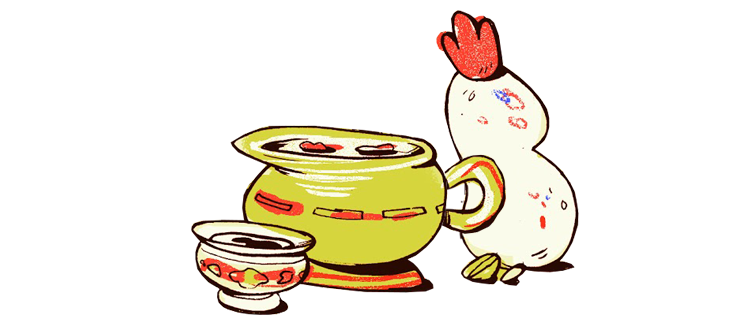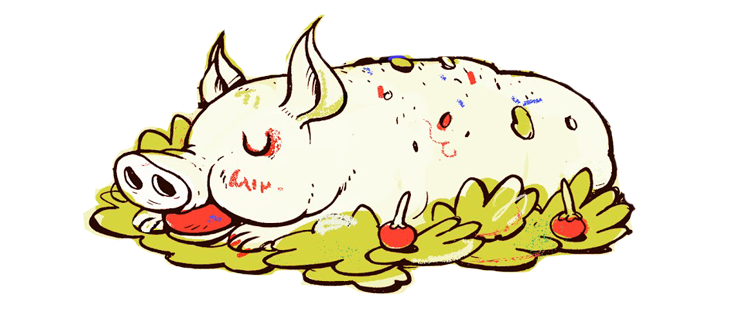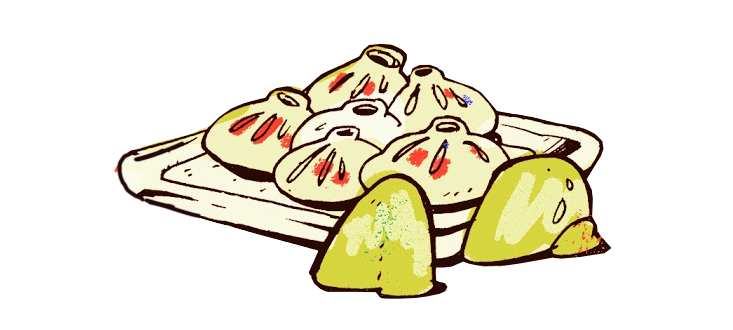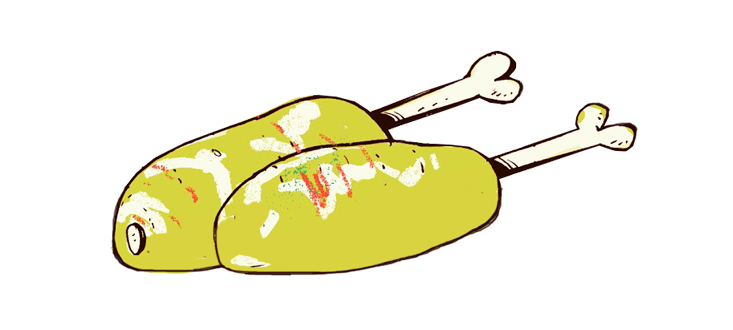In his legendary last battle with the traitorous Mordred, King Arthur suffers a blow to the skull. For a moment, it looks like the end. But then he is borne away to the island paradise of Avalon, where nine sisters feed him magic apples that grant him immortality. Supposedly, he is still there, waiting for the right moment to return to Britain and reclaim his throne.
What the medieval scribes failed to tell us about this recuperative exile was that Arthur almost certainly supped on fancier fare than fruit, including leek-onion porridge and wild game stew topped with asparagus and bulrush stems. How do we know? If Avalon were a real isle, the enchantresses who lived there probably cooked and ate similarly to other English aristocrats in the Middle Ages.
Food can reveal a lot about a place, even a mythical one. If we want a visitor to understand how we live, we invite him to dinner. When we wonder what life was like in fabled places like Avalon, Atlantis, and the Lost City of Z, a hypothetical menu can fill in a lot of the details.
I invite you, then, to sample the real foods of fantastical lost worlds. Using archaeological records from actual places that existed in a similar geography and time, I have constructed dinner menus for five fictional lands of legend. So even if Avalon was just a fever dream of a cleric’s overactive imagination, you can still prepare a feast worthy of King Arthur.
Atlantis
Appetizer
Fire-roasted fennel rubbed rack of lamb served on a bed of lentils, spiced with Mediterranean thyme
Entreé
Stewed rabbit cooked over an open flame in a barley porridge, packed with wild cabbage and turnips
Dessert
Hand-ground wheat cereal sweetened with honey and thickened with fresh goat’s milk
The myth of Atlantis was birthed in two short writings by the Greek philosopher Plato, who claimed that the lost isle existed 9,000 years before his time in the Atlantic Ocean, “beyond the Pillars of Hercules”—rocky outcrops flanking the entrance to the Mediterranean Sea. Unfortunately, the reign of this “great and wonderful empire” was short-lived. In “a single day and night of misfortune,” Plato wrote, “violent earthquakes and floods” annihilated the island, which “disappeared in the depths of the sea.”

There are few archaeological records from the time Atlantis supposedly thrived. But there are human remains dating from 5,000 B.C. located on a nearby island in the Maltese archipelago called Gozo, off the coast of Sicily. According to chemical analyses of these remains, prehistoric Gozo inhabitants subsisted mostly on domesticated plants and animals, including cows, sheep, goats, wheat and lentils. Finding no marine proteins in the their bones, scientists concluded that they didn’t avail themselves of the surrounding sea life. During poor crop years, however, they may have indulged in the island’s wild game, including deer and rabbits. Stone carvings and pottery shards from Malta’s prehistoric temples, built between 4,000 and 2,500 B.C., offer other possible sources for side dishes: fish, snakes, goats, birds, and bulls.
Lemuria
Appetizer
Freshly harvested tide-pool limpets (sea snails), steamed in taro leaves and accented with sea salt and ribbons of seaweed
Entreé
Whole pig broiled over an open fire, served with inamona relish made with mashed roasted kukui nuts
Dessert
Stewed taro in coconut milk with just-picked pineapple, strawberry guava and poha berries
The Eden-like wonderland of Lemuria supposedly spanned the Pacific and Indian Oceans more than 10,000 years ago. Legend has it that the islands now scattered throughout this region—Tahiti, Hawaii, Samoa and perhaps even Australia—are all that remain of this gigantic landmass. One theory depicts Lemuria as a land bridge between southern India and Africa, which could explain why similar flora and fauna have been observed on both continents, but not on the islands in between. Because the lemur once thrived in both places, for instance, 19th-century zoologist Philip L. Sclater dubbed the lost continent Lemuria.

If Lemuria was the motherland of ancient Pacific islanders, they may have preserved its food rituals over many generations. This lets us make a guess at the Lemurian cuisine based on what we know of the early Pacific Island diet. When Pacific Islander colonizers from Polynesia arrived in the Hawaiian Islands in the 3rd century A.D., they brought with them three domesticated animals: chickens, dogs and pigs. The latter was the centerpiece of sacrificial feasts, meant to “assure success in all ritual undertakings, including rites of passage, purification, propitiation, divination, and presentation,” according to anthropologist Michael J. Kolb. During the most lavish celebrations, held at luakini heiau (war temples), diners rounded up hundreds of pigs and burned or broiled them over open flames, producing a “fragrant essence or smoke that an ethereal being could consume,” Kolb writes. Alongside this plethora of pork was a selection of birds, fish, and shellfish, including limpets and crabs, as well as tropical fruits and vegetables such as taro and yams.
Avalon
Appetizer
Rustic porridge accentuated with foraged onions, leeks, and white mustard flowers
Entreé
Game pottage stew with wild asparagus and bulrush stems, accompanied by campfire-baked bread rolls
Dessert
Wood-fired apples roasted over an open flame, drizzled with wild honey and spiced with nutmeg and cinnamon
On the mystical medieval sanctuary of Avalon, inhabitants allegedly demurred from cultivation and simply foraged for fruits and grains growing on the fertile land. Some scholars have speculated that low-lying settlements in southern England, near the modern town of Glastonbury, were the inspiration for this legendary “island of apples.” Once surrounded by marshes, the area was a virtual island. Residents would have had a ready supply of fresh fish and shellfish as well as wild terrestrial game.

King Arthur probably enjoyed a richer and more varied diet than the commoners of his time. “Ordinary people mostly ate carbs,” says Allen Frantzen, author of Food, Eating, and Identity in Early Medieval England. Wild boar, deer and rabbit were delicacies. “Game was the real marker of an aristocratic diet.” According to Frantzen, hunters created elaborate field kitchens to cook such fine fare. They roasted meat on spits over open fire pits, simmered soups and porridges in iron cauldrons, and baked wild wheat bread in clay pots immersed in hot coals.
Additionally, if Arthur had the foresight to pack before his trip to Avalon, he probably brought spices along, perhaps mustard, parsley and sage—favorites of the upper echelons of medieval society. “They actually had a fairly wide range of spices to make food taste interesting or to cover up the taste of it going bad,” Frantzen says.
The Lost City of Z
Appetizer
Tucupi (manioc juice) stew featuring freshly caught jau and piraputanga fish
Entreé
Spit-roasted deer spiced with alfavaca (Amazonian basil) and accompanied by Brazil nuts and maize
Dessert
Cashew beiju (manioc cake), soaked in wild honey and topped with pequi and jocote fruits
According to legend, a jungle metropolis flourished in a 10-mile-wide valley at the heart of Brazil’s Mato Grosso region. Home to a highly advanced civilization in possession of an unfathomable abundance of gold, the Lost City of Z supposedly emerged hundreds of years ago, perhaps during the 1400s when the Incans built the neighboring estate Machu Picchu. In the early 20th century, explorer Percy Fawcett made it his life’s mission to find the mythic city. He spent years trudging through impenetrable and treacherous rainforest, but ultimately, the maddening quest led to his disappearance and presumed death.

The inhabitants of Z, if they ever existed, likely maintained large-scale cultivations of the starchy tuber manioc, a dietary mainstay in the region. Crop fields and rice paddies surrounded the city, according to Portuguese fortune hunters who clamed to have discovered its ruins in 1753. They also reported “innumerable swarms of hens and geese” and a variety of wild game. In 2009, in the nearby Taboco region, scientists discovered cave drawings between 4,000 and 10,000 years old depicting deer, armadillos, cats, birds and reptiles—a possible record of more exotic cuisines.
Shangri-La
Appetizer
Raw yak tongue dipped in dried chili pepper powder
Entreé
Roasted barley tsampa (flour) logs, enriched with dried dri (female yak) cheese
Dessert
Butter-rich, brown sugar thue (Tibetan pastry), served with po cha tea
Popularized in James Hilton’s 1933 novel Lost Horizon, Shangri-La allegedly still exists in the sweeping Kunlun Mountains running through Tibet, where its immortal—and secretive—residents live in peaceful harmony. Hilton claims that his descriptions of Shangri-La were inspired by the writings of two missionaries, Evariste Regis Huc and Joseph Gabet, who traveled through Tibet in the 1800s.

Not much has changed in traditional Tibetan cuisine since Hilton wrote his book, so it’s conceivable that the utopians of Shangri-La eat like modern Tibetans. The region’s food culture errs on the simple side, consisting mainly of barley, dairy, and meats, including plenty of offal (organ meat). Tsampa is a staple food made by kneading barley flour and salty butter tea into logs. (Dried dri cheese is an optional mix-in.) Yak, beef and mutton are also popular, eaten raw, cooked or dried into jerky. A popular dessert, served during holidays and ceremonies, is thue, an uncooked confection consisting of dried dri cheese, brown sugar, and butter. The go-to beverage is po cha, tea mixed with butter, milk, and salt.
Nevin Martell is a freelance food and travel writer and the author of several books, including Freak Show Without a Tent: Swimming With Piranhas, Getting Stoned in Fiji and Other Family Vacations. He hopes to one day have dinner in the Lost City of Z. Find him on Twitter @nevinmartell.


























